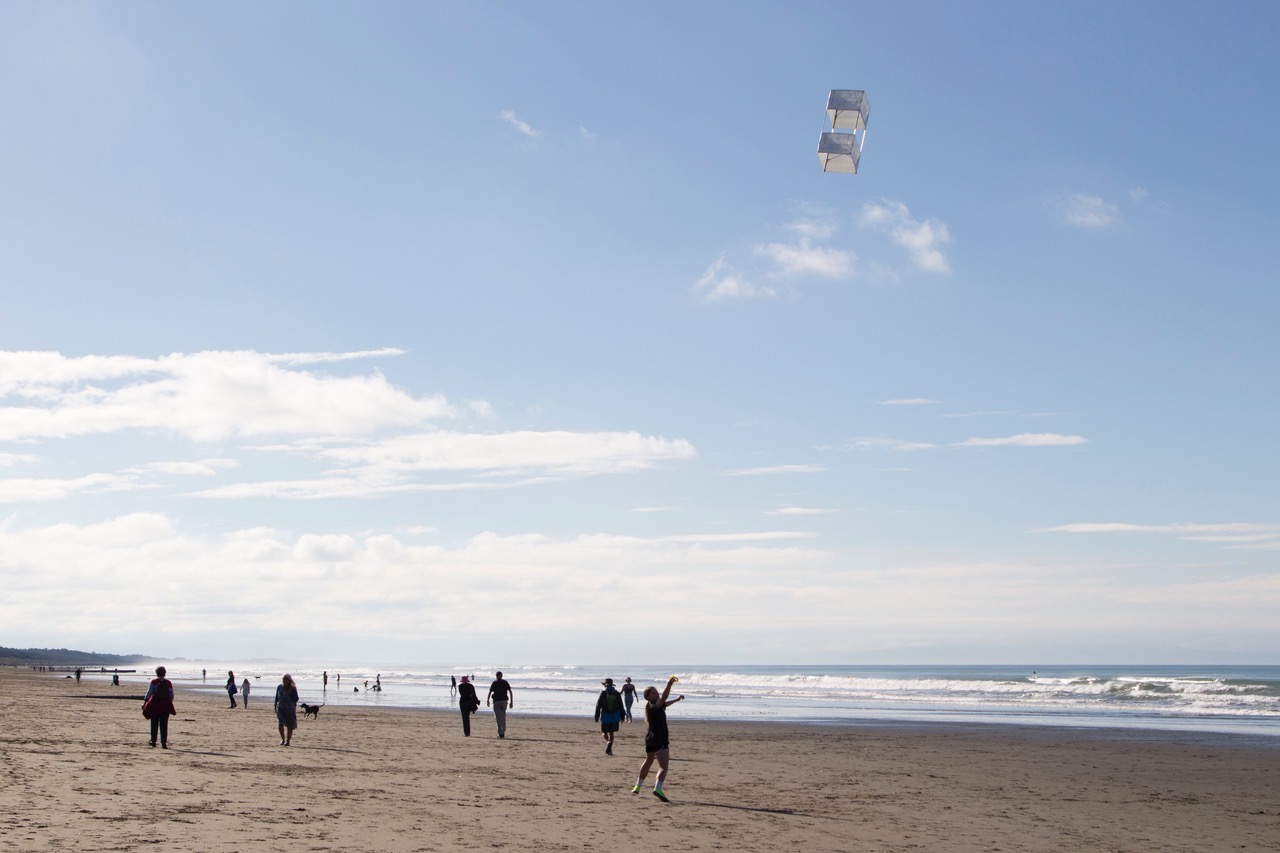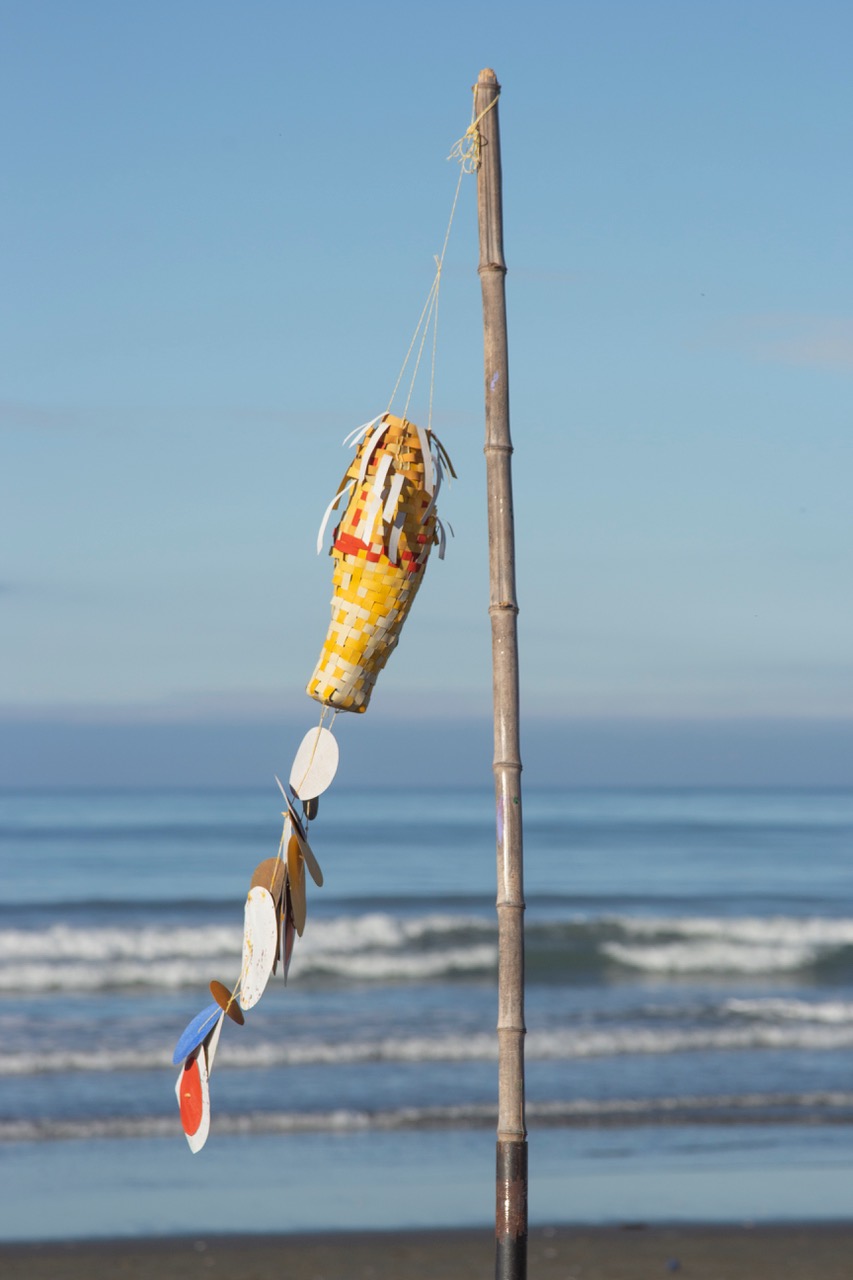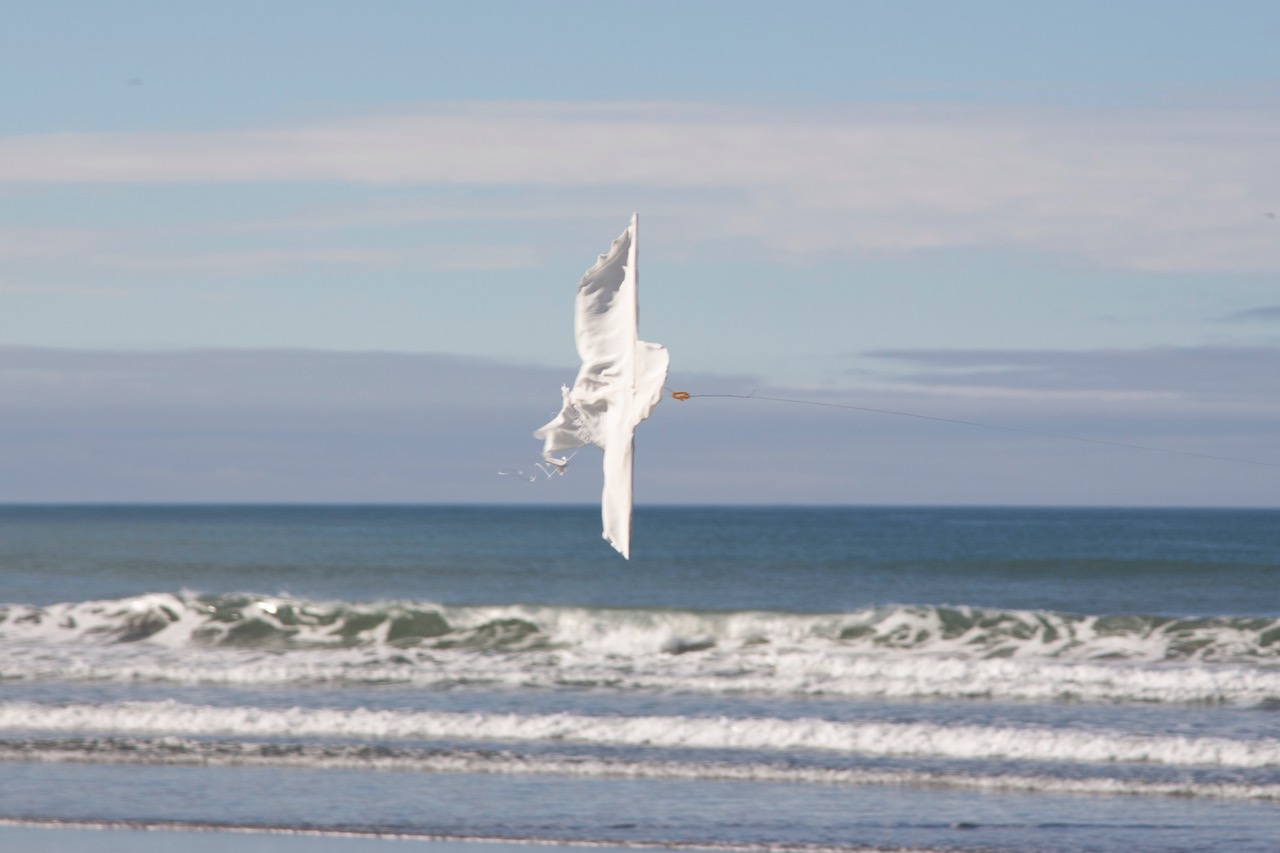
Aerodynamicas
A kite flying event by Milli Jannides and Nicola Farquhar
Aerodynamicas | Group exhibition | Waimairi Beach, Ōtautahi
22.07.23 | written by Jasmine Gallagher
Coordinates: 43°29'15.0"S 172°43'29.0"E
43 degrees, 29 minutes, 15 seconds south; 172 degrees, 43 minutes, 29 seconds east
![]() Kite by Jungeun Lee and Seung Yul Oh, 2023.Photo: Toni Cuthill.
Kite by Jungeun Lee and Seung Yul Oh, 2023.Photo: Toni Cuthill.
43 degrees, 29 minutes, 15 seconds south; 172 degrees, 43 minutes, 29 seconds east
 Kite by Jungeun Lee and Seung Yul Oh, 2023.Photo: Toni Cuthill.
Kite by Jungeun Lee and Seung Yul Oh, 2023.Photo: Toni Cuthill. For my birthday this year I received a kite. I hadn’t flown a kite since I was a little, and it was lots of fun taking it down to our local park with my partner and our baby to fly it. There was plenty of laughter and an abundance of childlike joy as the kite tugged at the string, up high in the easterly above a big green field in the early evening sky. On the way home I noticed I’d received an email asking if I’d be interested in writing about a kite flying day, featuring kites made by local creatives. Having recently put my PhD on contemporary art and poetry on a deferral—partly due to my boredom with the current obsession with identity politics in academia, alongside demoralising job cuts and the shrinking of humanities departments—engaging in a kite flying day felt like an opportunity to bring a bit of fun back to my writing. And the serendipity of the email added to this more optimistic feeling.
As we arrived at Aerodynamicas it was immediately evident that there was very little wind. After months of a predominantly chilly easterly in Christchurch, the conditions were certainly not the best for kite flying. Despite this there was plenty of room for people to run along the beach so that their kites took flight behind them. There was also a huge pile of driftwood that formed a kind of display plinth for the artists to rest their kites on. And it was so warm and sunny that a different kind of event unfolded, one that allowed us to bask in the sun and enjoy the scenery, rather than bracing against the easterly as is typical along New Brighton beaches. People could relax and enjoy mingling and chatting, as well as the sharing of baked goods, picnic-style, in a way that might’ve been less inviting on a windy day.
As we arrived at Aerodynamicas it was immediately evident that there was very little wind. After months of a predominantly chilly easterly in Christchurch, the conditions were certainly not the best for kite flying. Despite this there was plenty of room for people to run along the beach so that their kites took flight behind them. There was also a huge pile of driftwood that formed a kind of display plinth for the artists to rest their kites on. And it was so warm and sunny that a different kind of event unfolded, one that allowed us to bask in the sun and enjoy the scenery, rather than bracing against the easterly as is typical along New Brighton beaches. People could relax and enjoy mingling and chatting, as well as the sharing of baked goods, picnic-style, in a way that might’ve been less inviting on a windy day.

Kite by Elle Loui August, 2023.
Photo: Toni Cuthill.
Two kites in particular caught my eye: one primarily for its aesthetics, and one for more functional reasons. A knitted kite made collaboratively by friends Megan Brady and Georgina May Young featured wool dyed by Young and knitted by Brady. The colours created by natural dyes reminded me of the ones my grandma used to use in her knitting and felting, and incidentally Brady had knitted the kite while visiting her nanna, who also helped with the design. A striped pattern over the diamond frame of the kite featured wool dyed by sticta coronata (windfallen lichen), rata bark, walnut, tansy, onion skins, kotukutuku bark and privet berries. The frame was also made by Young using plum prunings from her garden. Although this was not a flying kite, it was an excellent example of collaborative craftsmanship using locally found materials, that both crossed generations and was closely linked to the natural environment.
Another collaborative effort was by Natalie Bascand and her partner Rick Tapper. They had created a very effective cylindrical box kite that they managed to launch and fly well on the day due to some good running speed on Tapper’s part, and a hefty throw by Bascand. The frame of this kite was made from dowel and bamboo. Recycled packaging had been attached to it to create the sails, also referred to as ribbons, like two rigid cylinders or cells. I had not seen a kite like this before and found that they were invented in 1893 by the aviation experimenter Lawrence Hargrave in his attempt to develop a flying machine, which was somewhat successful: one attempt with four box kites joined together managed to lift him nearly 5 meters off the ground, but failure was often immanent, and this acceptance of possible failure could be seen in Aerodynamicas because the lack of wind meant that many of the kites did not fly well, if at all. This meant the artists had to take a risk and be prepared to court a bit of foolery in their kite flying attempts.
Another collaborative effort was by Natalie Bascand and her partner Rick Tapper. They had created a very effective cylindrical box kite that they managed to launch and fly well on the day due to some good running speed on Tapper’s part, and a hefty throw by Bascand. The frame of this kite was made from dowel and bamboo. Recycled packaging had been attached to it to create the sails, also referred to as ribbons, like two rigid cylinders or cells. I had not seen a kite like this before and found that they were invented in 1893 by the aviation experimenter Lawrence Hargrave in his attempt to develop a flying machine, which was somewhat successful: one attempt with four box kites joined together managed to lift him nearly 5 meters off the ground, but failure was often immanent, and this acceptance of possible failure could be seen in Aerodynamicas because the lack of wind meant that many of the kites did not fly well, if at all. This meant the artists had to take a risk and be prepared to court a bit of foolery in their kite flying attempts.
Photo: Milli Jannides.
Post-critical theorist Rita Felski argues that critique can become overly cynical and skeptical when it constantly focuses on injustice in a serious manner, rather than the best in humanity and emotions like hope, humour and joy.1 This means that critiques of different aspects of collective art making and exhibiting, including aesthetics and functionality, are necessary because they shift the focus from the past injustices associated with different identities to imagine positive new futures and forms of solidarity, whether that be via different forms of collaboration, or an ability to laugh at ourselves together. Aerodynamicas represented this hopeful notion for me because it was a beautiful outdoor event enjoyed by artists and their family and friends, with an openness to involve children that felt especially unique. And the way that the artworks were not on display or for sale to the public in a gallery meant that the event was free from the need to ensure exact representation or to count visitors. Aerodynamicas took on a very special, almost utopian nature accordingly: the kites flying in the sky, resting on the driftwood, and reflecting the light in front of the crashing waves and a happy gathering, on a beach looking out to the edge of a world full of possibility.
![]()
1. Rita Felski, The Limits of Critique (Chicago; London: University of Chicago Press, 2015)
Article image: Aerodynamicas, organised by Milli Jannides and Nicola Farquhar, 2023. Photo: Toni Cuthill.
Photos courtesy of Aerodynamicas and the artists.
Aerodynamicas was an initiative led by artists Milli Jannides and Nicola Farquhar at Waimairi Beach in Ōtautahi on the 22nd of April 2023. There were more than thirty artists from around the motu involved in making and flying for this event.
1. Rita Felski, The Limits of Critique (Chicago; London: University of Chicago Press, 2015)
Article image: Aerodynamicas, organised by Milli Jannides and Nicola Farquhar, 2023. Photo: Toni Cuthill.
Photos courtesy of Aerodynamicas and the artists.
Aerodynamicas was an initiative led by artists Milli Jannides and Nicola Farquhar at Waimairi Beach in Ōtautahi on the 22nd of April 2023. There were more than thirty artists from around the motu involved in making and flying for this event.
 Kite by Nicola Shanley, 2023.
Kite by Nicola Shanley, 2023. Photo: Toni Cuthill.
ISSN 2744-7952
Thank you for reading ︎
Vernacular logo designed by Yujin Shin
vernacular.criticism ︎

